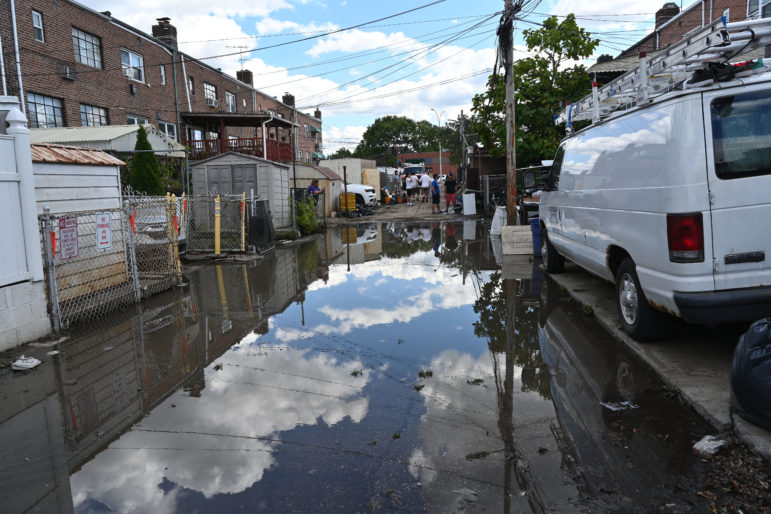Absent a flood history database, prospective renters and homebuyers are often on their own to determine whether a property has had water damage, especially in homes outside flood zones which are now seeing more frequent issues from increased rainfall.

Kevin P. Coughlin / Office of the Governor
Flooding in Queens following Hurricane Ida.Nearly two months after Hurricane Ida flooded his Flushing basement, Vicente Guerrero is still looking for an apartment.
Guerrero, a food delivery worker from Mexico, has spent the past several weeks crashing on the floor of his friend’s Manhattan apartment while he hunts for a new place, one that he can afford and that floodwaters can’t reach. But the latter criteria can be difficult to decipher.
“If I had known that that area where I lived was a flood-prone zone, I would not have lived there,” Guerrero said Wednesday. “But who knows that?”
Ida flooded homes across the city, killing 13 people, including 11 in basement apartments, while destroying homes and displacing New Yorkers, like Guerrero, who do not live near the city’s coastlines. Residents in the flood zone can presume a certain risk, but New Yorkers elsewhere may be unlikely to realize an apartment is in danger—like the people living in homes built atop marshlands, streams and ponds long ago filled in and redeveloped, or those who live in low-lying areas where century-old sewers could not handle an historic downpour.
Stormwater flood maps published by the city in May show the likelihood of flooding on a block-by-block level, but there is no mechanism that allows prospective renters, or even buyers, to look up a building’s complete flood history and determine if a home is worth the risk.
New York State law mandates that sellers of any one- to four-unit building provide buyers with a Property Condition Disclosure Statement that includes questions about flooding, but they can avoid that requirement by simply providing a $500 credit at closing. Most property owners choose the credit. Insurance companies can access claim information through the Comprehensive Loss Underwriting Exchange (CLUE), but do not disclose it except upon individual request.
But creating a flood history database with public information is certainly possible, said Steph Rudolph, deputy director at JustFix.nyc, which aggregates Department of Housing Preservation and Development (HPD) violations, property records and other building data for residences across the city.
“I don’t think it would be hard to create. You could use open data to look for HPD violations,” Rudolph said, listing complaints like mold, leaks and peeling paint that likely indicate water damage. “If you take those violations together, you can tell that’s a very leaky building.”
That data won’t paint a complete picture, however. Tenants in illegal basement apartments or market-rent units not subject to rent stabilization laws are unlikely to report landlords who may in turn deny them future leases or raise their rents, Rudolph said.
State lawmakers could pass a measure mandating that property owners disclose a building’s flood history, similar to existing laws requiring landlords to share information about lead paint or bed bug infestations, but that may have little impact. “By lease signing you’re kind of locked in anyway, so none of those laws are helpful,” she said.
It’s unclear if the city has any appetite for establishing flood disclosure requirements or creating a searchable database to alert renters or buyers of unforeseen risk. HPD, the Department of Buildings and the Office of Emergency Management did not respond to multiple requests for comment for this story.
That may be because city officials are reluctant to disrupt the housing or rental market, said Jeff Schneider, president of Brooklyn-based Gotham Brokerage. The same is true for the Federal Emergency Management Administration (FEMA) and insurance companies, which do not look into or disclose much water damage information to buyers outside of flood zones, Schneider added.
“If I were a buyer I would want to know if there was fire or water damage and it was dealt with,” he said. “The problem is disclosing that information because it might impact the marketability of your residence and it’s not fair if you’ve done repairs and addressed the damage.”
As the city seeks to move people out of flood prone coastal homes—a concept known as “managed retreat”— a flood history database could help renters and buyers understand potential risks, Schneider added.
“With caveats that mistakes can be made, it’s not a bad idea,” he said. “And it may well be more of an issue in the future.”
A rising tide
All signs certainly point to future flooding—from storm surges like Hurricane Sandy, but also from intense rains fueled by climate change that overrun the city’s drainage system, like the storm that killed New Yorkers inside their homes last month. The Mayor’s Office released a report in the wake of Ida calling such extreme storms “the new normal” in New York City.
Some of the worst flooding occurred along historic waterways long since filled in for residential development, like a subdivision surrounded by Kissena Park, site of the old Kissena Creek. The historic downpour found its way back there, killing three people inside their homes.
New Yorkers in residences near Kissena Park, particularly renters, would have no way of knowing they lived on an old stream unless they perused century-old maps or happened to consult with Dr. Eric Sanderson, a senior conservation ecologist at the Wildlife Conservation Society.
Sanderson has created detailed maps that layer modern New York City over the shape of the archipelago as it looked hundreds of years ago: a vast network of streams, creeks and marshes. Sanderson described the way heavy rain tends to find its original pathways in an essay for the New York Times following Ida.
But city agencies do not publicize a community’s historic terrain, or what that might mean for modern residents.
“The city planning review doesn’t take into account historical ecology, it’s all about the environment of today,” Sanderson said. “But the climate is changing and we’ve so modified the landscape that it’s hard for [the land] to do the adjustments that it had done for millions of years, billions of years.”
Some private companies have stepped in to provide searchable flood risk information, but rarely specific home histories.
The firm Open Igloo compiles HPD complaints, property records and landlord reviews on its smartphone app. The company ClimateCheck enables users to enter their address and obtain a free flood risk assessment based on regional weather history and future predictions.
ClimateCheck does not delve into the specific flood or fire history of a property, but provides a regional overview that is free of charge.
Additional information about past flooding would allow renters and buyers to make more informed decisions, though it could have consequences when it comes to insurance or lending, said ClimateCheck Environmental Scientist Maximilian Stiefel.
“It’s complicated because it brings into question the way data would be used by third parties, like insurers, government and mortgage lenders. How that would change their decision making is pretty relevant,” he said. “It seems like the real estate industry is pretty receptive to this stuff so far.”
How to identify past flooding
Absent a flood history database, prospective renters and homebuyers are often on their own to determine whether a property has had water damage, especially in homes outside flood zones.
Some tenants know what to look for. A neighborhood with the word “Heights” in its name is a start, though the city flood maps show “deep and contiguous flooding”—water at least a foot high—in Jackson Heights and on the edges of Dyker Heights.
Williamsbridge resident Shamaya Morris recently lost her basement apartment after Ida and moved in with her uncle as she looks for a new place. She said her grandfather taught her to examine the bottom of doors, the inside of cabinets and the base of the toilet to check for potential water damage.
“If the bottoms of the doors are expanded or they’ve got bends in them, normally that’s a sign the place flooded,” Morris said. “A different color, even a slight shade off, if the top is lighter than the bottom that’s a clear sign that there’s been flooding.”
The strategy isn’t foolproof. “If there were renovations to the apartment it’s extremely hard, but you can still see some things,” she said.
Open HPD violations will also provide some clues, but once the complaints are closed they are more difficult to access. Rudolph, the policy director at Just Fix, said closed HPD violations are only available through a Freedom of Information Law request, which tend to take a while.
“If you’re in an apartment hunt I don’t know how FOILing closed violations is realistic,” she said.
Prospective tenants can also check the top 311 complaints for a property by visiting Just Fix’s Who Owns What database. Several complaints related to water damage are a red flag, she said.
Prospective tenants and buyers could also just ask the property owners about the flood history, though that may not work in a hot housing market where many owners are faceless LLCs and buyers are pressured to move quickly, or risk losing a home to the next bidder.
“During the pandemic, there were certainly a lot of first time homebuyers and we did see people buying problematic houses,” said Schneider, of Gotham Brokerage. “It would be good to know [about flooding] because at a minimum, you can keep material in your home, like blocks or planks to get stuff off the floor.”
The rental market is also returning to pre-pandemic levels of competition, once more punishing tenants who don’t move quickly.
That’s all the more reason why New York City should help renters and buyers search home flood histories, said Sateesh Nori, the head of Legal Aid’s Queens Housing Unit. He spoke by phone while visiting an Astoria client dealing with the aftermath of Ida, which left four feet of floodwater in her basement apartment. The water receded after a day, but the landlord has yet to address the damage, said Nori and the woman’s son.
“It’s buyer beware,” Nori said. “This is a market for professionals, for sharks, whether you’re a tenant or seeking to be a homeowner.”










